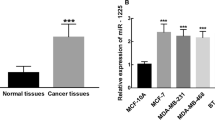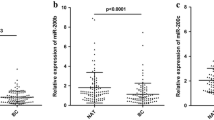Abstract
Triple-negative breast cancer is a special type of breast cancer, characterized by younger onset age, shorter survival period, higher malignant degree, higher mortality, recurrence and metastasis. Triple-negative breast cancer is more harmful to women's life and health, compared with other types of breast cancer. This paper mainly studied the role of miR-585 in triple-negative breast cancer. Real-time quantitative PCR was used to detect the expression of miR-585 in triple-negative breast cancer cell lines and tissues. Kaplan–Meier curve and Cox proportional hazards model analysis were used to investigate the prognostic value of miR-585 in triple-negative breast cancer. CCK-8 and Transwell assays were used to detect cell proliferation, invasion and migration. miR-585 was significantly down-regulated in triple-negative breast cancer cells and tissues. The low expression of miR-585 has been shown to be significantly associated with poor prognosis in triple-negative breast cancer patients. Abnormally low expression of miR-585 can promote cell proliferation, migration and invasion. Overall, abnormally low expression of miR-585 is associated with prognosis and progression of triple-negative breast cancer. miR-585 may serve as a prognostic biomarker for patients with triple-negative breast cancer and it is expected to be a new method and strategy for the treatment of triple-negative breast cancer.




Similar content being viewed by others
References
Jiang F, Zhang L, Liu Y, Zhou Y, Wang H. Overexpression of miR-331 indicates poor prognosis and promotes progression of breast cancer. Oncol Res Treat. 2020;43:441–8.
Li MX, Jin LT, Wang TJ, et al. Identification of potential core genes in triple negative breast cancer using bioinformatics analysis. Onco Targets Ther. 2018;11:4105–12.
Shi D, Li Y, Fan L, et al. Upregulation of miR-153 inhibits triple-negative breast cancer progression by targeting ZEB2-mediated EMT and contributes to better prognosis. Onco Targets Ther. 2019;12:9611–25.
Guan X, Gu S, Yuan M, Zheng X, Wu J. MicroRNA-33a-5p overexpression sensitizes triple-negative breast cancer to doxorubicin by inhibiting eIF5A2 and epithelial-mesenchymal transition. Oncol Lett. 2019;18:5986–94.
Wu X, Ding M, Lin J. Three-microRNA expression signature predicts survival in triple-negative breast cancer. Oncol Lett. 2020;19:301–8.
Gui Y, Xu S, Yang X, et al. A meta-analysis of biomarkers for the prognosis of triple-negative breast cancer patients. Biomark Med. 2016;10:771–90.
Braicu C, Raduly L, Morar-Bolba G, et al. Aberrant miRNAs expressed in HER-2 negative breast cancers patient. J Exp Clin Cancer Res CR. 2018;37:257.
Shen X, Lei J, Du L. miR-31-5p may enhance the efficacy of chemotherapy with Taxol and cisplatin in TNBC. Exp Ther Med. 2020;19:375–83.
Si C, Yu Q, Yao Y. Effect of miR-146a-5p on proliferation and metastasis of triple-negative breast cancer via regulation of SOX5. Exp Ther Med. 2018;15:4515–21.
Liang H, Huang W, Wang Y, Ding L, Zeng L. Overexpression of MiR-146a-5p Upregulates lncRNA HOTAIR in triple-negative breast cancer cells and predicts poor prognosis. Technol Cancer Res Treat. 2019;18:1533033819882949.
Zhao M, Zhang M, Tao Z, et al. miR-331-3p suppresses cell proliferation in TNBC Cells by downregulating NRP2. Technol Cancer Res Treat. 2020;19:1533033820905824.
Wang Z, Sha HH, Li HJ. Functions and mechanisms of miR-186 in human cancer. Biomed Pharmacother = Biomedecine pharmacotherapie. 2019;119:109428.
Li M, Pan M, You C, Dou J. The therapeutic potential of miR-7 in cancers. Mini Rev Med Chem. 2019;19:1707–16.
Zhu L, Deng H, Hu J, et al. The promising role of miR-296 in human cancer. Pathol Res Pract. 2018;214:1915–22.
Toda H, Kurozumi S, Kijima Y, et al. Molecular pathogenesis of triple-negative breast cancer based on microRNA expression signatures: antitumor miR-204-5p targets AP1S3. J Hum Genet. 2018;63:1197–210.
Camorani S, Fedele M, Zannetti A, Cerchia L. TNBC challenge: oligonucleotide aptamers for new imaging and therapy modalities. Pharmaceuticals. 2018. https://doi.org/10.3390/ph11040123.
Wang L, Liu D, Wu X, et al. Long non-coding RNA (LncRNA) RMST in triple-negative breast cancer (TNBC): expression analysis and biological roles research. J Cell Physiol. 2018;233:6603–12.
Zhang L, Du Y, Xu S, et al. DEPDC1, negatively regulated by miR-26b, facilitates cell proliferation via the up-regulation of FOXM1 expression in TNBC. Cancer Lett. 2019;442:242–51.
Chen H, Pan H, Qian Y, Zhou W, Liu X. MiR-25-3p promotes the proliferation of triple negative breast cancer by targeting BTG2. Mol Cancer. 2018;17:4.
Chang-Qing Y, Jie L, Shi-Qi Z, et al. Recent treatment progress of triple negative breast cancer. Prog Biophys Mol Biol. 2020;151:40–53.
Bar I, Theate I, Haussy S, et al. MiR-210 is overexpressed in tumor-infiltrating plasma cells in triple-negative breast cancer. J Histochem Cytochem Off J Histochem Soc. 2020;68:25–32.
Yu B, You W, Chen G, Yu Y, Yang Q. MiR-140-5p inhibits cell proliferation and metastasis by regulating MUC1 via BCL2A1/MAPK pathway in triple negative breast cancer. Cell cycle (Georgetown, Tex). 2019;18:2641–50.
Piasecka D, Braun M, Kordek R, Sadej R, Romanska H. MicroRNAs in regulation of triple-negative breast cancer progression. J Cancer Res Clin Oncol. 2018;144:1401–11.
Weng YS, Tseng HY, Chen YA, et al. MCT-1/miR-34a/IL-6/IL-6R signaling axis promotes EMT progression, cancer stemness and M2 macrophage polarization in triple-negative breast cancer. Mol Cancer. 2019;18:42.
Liu S, Wang Z, Liu Z, et al. miR-221/222 activate the Wnt/β-catenin signaling to promote triple-negative breast cancer. J Mol Cell Biol. 2018;10:302–15.
Mekala JR, Naushad SM, Ponnusamy L, et al. Epigenetic regulation of miR-200 as the potential strategy for the therapy against triple-negative breast cancer. Gene. 2018;641:248–58.
Xiao Y, Humphries B, Yang C, Wang Z. MiR-205 dysregulations in breast cancer: the complexity and opportunities. Non-coding RNA. 2019. https://doi.org/10.3390/ncrna5040053.
Ding X, Yang Y, Sun Y, et al. MicroRNA-585 acts as a tumor suppressor in non-small-cell lung cancer by targeting hSMG-1. Clin Transl Oncol Off Publ Fed Span Oncol Soc Natl Cancer Inst Mex. 2017;19:546–52.
Hu L, Wu H, Wan X, et al. MicroRNA-585 suppresses tumor proliferation and migration in gastric cancer by directly targeting MAPK1. Biochem Biophys Res Commun. 2018;499:52–8.
Liu C, Yang J, Wu H, Li J. Downregulated miR-585-3p promotes cell growth and proliferation in colon cancer by upregulating PSME3. Onco Targets Ther. 2019;12:6525–34.
Funding
No funding was received for conducting this study.
Author information
Authors and Affiliations
Contributions
MY and PF contributed to the study conception and design. Material preparation, data collection and analysis were performed by MY, SW, LC and BW. The first draft of the manuscript was written by MY and all authors commented on previous versions of the manuscript. All authors read and approved the final manuscript.
Corresponding author
Ethics declarations
Conflict of interest
The authors have no conflict of interest to declare that are relevant to the content of this article.
Availability of data and material
The datasets used and/or analyzed during the current study are available from the corresponding author on reasonable request.
Ethics approval
The ethics committee of The First Affiliated Hospital, College of Medicine, Zhejiang University approved this study.
Consent to participate
Informed consent was obtained from all individual participants included in the study.
Consent for publication
The participant has consented to the submission of the case report to the journal.
Additional information
Publisher's Note
Springer Nature remains neutral with regard to jurisdictional claims in published maps and institutional affiliations.
Rights and permissions
About this article
Cite this article
Yao, M., Wang, S., Chen, L. et al. Research on correlations of miR-585 expression with progression and prognosis of triple-negative breast cancer. Clin Exp Med 22, 201–207 (2022). https://doi.org/10.1007/s10238-021-00704-0
Received:
Accepted:
Published:
Issue Date:
DOI: https://doi.org/10.1007/s10238-021-00704-0




